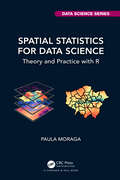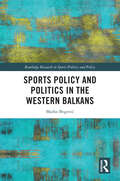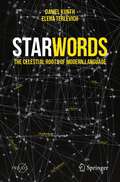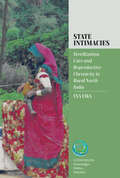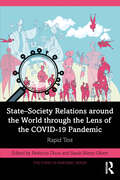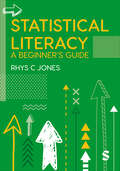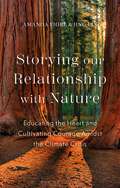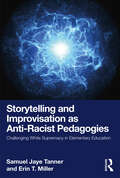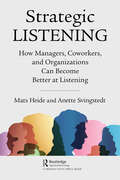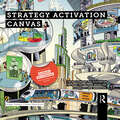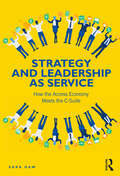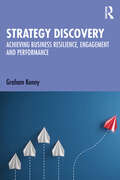- Table View
- List View
Spatial Statistics for Data Science: Theory and Practice with R (Chapman & Hall/CRC Data Science Series)
by Paula MoragaSpatial data is crucial to improve decision-making in a wide range of fields including environment, health, ecology, urban planning, economy, and society. Spatial Statistics for Data Science: Theory and Practice with R describes statistical methods, modeling approaches, and visualization techniques to analyze spatial data using R. The book provides a comprehensive overview of the varying types of spatial data, and detailed explanations of the theoretical concepts of spatial statistics, alongside fully reproducible examples which demonstrate how to simulate, describe, and analyze spatial data in various applications. Combining theory and practice, the book includes real-world data science examples such as disease risk mapping, air pollution prediction, species distribution modeling, crime mapping, and real state analyses. The book utilizes publicly available data and offers clear explanations of the R code for importing, manipulating, analyzing, and visualizing data, as well as the interpretation of the results. This ensures contents are easily accessible and fully reproducible for students, researchers, and practitioners. Key Features: Describes R packages for retrieval, manipulation, and visualization of spatial data Offers a comprehensive overview of spatial statistical methods including spatial autocorrelation, clustering, spatial interpolation, model-based geostatistics, and spatial point processes Provides detailed explanations on how to fit and interpret Bayesian spatial models using the integrated nested Laplace approximation (INLA) and stochastic partial differential equation (SPDE) approaches
Spatial Statistics for Data Science: Theory and Practice with R (Chapman & Hall/CRC Data Science Series)
by Paula MoragaSpatial data is crucial to improve decision-making in a wide range of fields including environment, health, ecology, urban planning, economy, and society. Spatial Statistics for Data Science: Theory and Practice with R describes statistical methods, modeling approaches, and visualization techniques to analyze spatial data using R. The book provides a comprehensive overview of the varying types of spatial data, and detailed explanations of the theoretical concepts of spatial statistics, alongside fully reproducible examples which demonstrate how to simulate, describe, and analyze spatial data in various applications. Combining theory and practice, the book includes real-world data science examples such as disease risk mapping, air pollution prediction, species distribution modeling, crime mapping, and real state analyses. The book utilizes publicly available data and offers clear explanations of the R code for importing, manipulating, analyzing, and visualizing data, as well as the interpretation of the results. This ensures contents are easily accessible and fully reproducible for students, researchers, and practitioners. Key Features: Describes R packages for retrieval, manipulation, and visualization of spatial data Offers a comprehensive overview of spatial statistical methods including spatial autocorrelation, clustering, spatial interpolation, model-based geostatistics, and spatial point processes Provides detailed explanations on how to fit and interpret Bayesian spatial models using the integrated nested Laplace approximation (INLA) and stochastic partial differential equation (SPDE) approaches
Sport in der totalen Institution – eine Gefängnisethnographie (Sport – Gesellschaft – Kultur)
by Johannes MüllerJustizvollzugsanstalten müssen Gefangenen die Möglichkeit anbieten, sich sportlich zu betätigen. Basierend auf mehrjähriger ethnographischer Forschung in einem Gefängnis untersucht das Buch die vielschichtigen Bedeutungen, die der Sport aus Sicht der Gefangenen besitzt. Die Befunde zeigen, dass sich Sport für einen Teil der männlichen Insassen als Bewältigungsstrategie zur Linderung der hafttypischen Belastungen erweist, indem er Freiheitsmomente birgt und Möglichkeiten eröffnet, gefängnistypischen Gefühlen von Angst, Einsamkeit, Langeweile und mentaler Niedergeschlagenheit zu begegnen. Darüber hinaus stellt der Sport ein probates Mittel zur Konstruktion bzw. Verteidigung von Männlichkeit, zur Selbstaufwertung und zur Positionierung in der sozialen Hierarchie unter den Gefangenen dar. Die Befunde zeigen weiterhin, dass speziell die Teilhabe an anstaltsorganisierten Sportangeboten voraussetzungsvoll ist und das besondere Gefängnissetting viele Inhaftierte von einer Sportteilhabe abhält.
Sports Policy and Politics in the Western Balkans (Routledge Research in Sport Politics and Policy)
by Marko BegovićThis book examines how states in the post-socialist Western Balkans region have used sport as a policy tool, and how sport in the region has been shaped by politics, history, and culture. Looking closely at the intersection of sports policy and politics in the countries of Serbia, Montenegro, Croatia, and Bosnia and Herzegovina, this book explores the roles of sport in nation-building and how sport has been used by regimes looking to establish political legitimacy in the transition from the post-socialist era. It offers a fascinating insight into the way that sport has been co-opted for political purposes, and into the complexities of formulating sports policy and wider public policy in societies in which governance structures may be weak and in which clientelism, corruption, and partisanship pose constant challenges. This book is fascinating reading for anybody with an interest in the history and politics of sport, in public policy, or in the history, politics, and culture of the former Yugoslav countries.
Sports Policy and Politics in the Western Balkans (Routledge Research in Sport Politics and Policy)
by Marko BegovićThis book examines how states in the post-socialist Western Balkans region have used sport as a policy tool, and how sport in the region has been shaped by politics, history, and culture. Looking closely at the intersection of sports policy and politics in the countries of Serbia, Montenegro, Croatia, and Bosnia and Herzegovina, this book explores the roles of sport in nation-building and how sport has been used by regimes looking to establish political legitimacy in the transition from the post-socialist era. It offers a fascinating insight into the way that sport has been co-opted for political purposes, and into the complexities of formulating sports policy and wider public policy in societies in which governance structures may be weak and in which clientelism, corruption, and partisanship pose constant challenges. This book is fascinating reading for anybody with an interest in the history and politics of sport, in public policy, or in the history, politics, and culture of the former Yugoslav countries.
Städte auf dem Weg zur Nachhaltigkeit: Ethnographische Einblicke und Analysen (VerKörperungen/MatteRealities - Perspektiven empirischer Wissenschaftsforschung #28)
by Britta AckselAngesichts von Extremwetterereignissen, Klimaprognosen und Bewegungen wie Fridays for Future lässt sich schwer leugnen, dass ein Teil der Menschheit auf eine Weise lebt, die eine gut bewohnbare Welt höchst unwahrscheinlich macht. Städten wird in dieser Situation eine zentrale Rolle zugeschrieben. Sie können die Welt vor der Erderwärmung retten - oder sie sind die Ersten, die untergehen. Doch was genau wird getan, um Städte in Richtung Nachhaltigkeit zu transformieren? Britta Acksel nimmt Aktionspläne, Klimafestivals, Awards und weitere Transformationsinstrumente in den Blick. Ethnographisch fundiert zeigt sie auf, wie sich die Arbeit mit dieser speziellen Form von Policy-Werkzeugen gestaltet - und welche Bemühungen besonders aussichtsreich erscheinen.
StadtTeilen: Neue Praktiken gemeinschaftlicher Nutzung urbaner Räume (Urban Studies)
by Floris Bernhardt Nada Bretfeld Josefine Buzwan-Morell Helena Cermeño Sina Doukas Elisabeth Güde Constantin Hörburger Carsten Keller Florian KochPraktiken des Teilens stellen Möglichkeiten dar, Stadt alternativ zu gestalten, und sind zugleich komplexe Aushandlungsprozesse. Kann der Schulhof abends von der Nachbarschaft genutzt werden? Oder hat die Hausgemeinschaft Interesse an einem gemeinsamen Garten und Veranstaltungsraum? Offen ist, was solidarische und widerständige Praxen des Teilens begünstigt und welche architektonischen Interventionen die Teilbarkeit von öffentlichem Raum erleichtern. Auf der Grundlage empirischer Studien in drei deutschen Städten und einem Praxislabor werden Praktiken des Teilens, ihre Bedingungen, Potenziale und Grenzen untersucht. Die Autor*innen liefern Denkanstöße für Politik, Verwaltung, Wissenschaft, Initiativen und Wohnungsunternehmen.
StarWords: The Celestial Roots of Modern Language (Springer Praxis Books)
by Daniel Kunth Elena TerlevichUnbeknownst to many, our modern language contains countless words that were inspired by human observations of the cosmos. We now use words like “zenith”, “Monday”, “disaster”, “dog days”, “starfish”, “lunatic”, flu, and so many others, without a second thought for their celestial roots. Famous French astrophysicist Daniel Kunth invites you on a linguistic and scientific journey through space and time to explore these forgotten origins. You will be astonished to rediscover cosmic language hidden in plain sight through this wonderful collection of historical and cultural stories, famous idioms and delightful puns, along with the real science behind each one. Elena Terlevich is a well known professional astronomer working at INAOE in Mexico, an honorary Professor at La Plata University in Argentina and a regular visitor at the Institute of Astronomy in Cambridge (UK). Requiring no prior knowledge in astronomy or linguistics, this book’s universal contentsinvite the reader to ponder how our observations of the night sky have shaped our modern tongue and customs.
State Intimacies: Sterilization, Care and Reproductive Chronicity in Rural North India (Lifeworlds: Knowledges, Politics, Histories #4)
by Eva FiksThe public healthcare system in rural India is chronically under-resourced. It embodies and often perpetuates the wider politics of the Indian state towards its rural communities with provisions of care that are deeply entangled with violence and disgust. For rural women, such care deepens reproductive chronicity while providing temporary relief. Grounded in women’s everyday realities and experiences in sterilization camps and other healthcare settings in rural Rajasthan, State Intimacies examines the mundane workings, ambiguities and fragilities of care in post-colonial rural North India.
State–Society Relations around the World through the Lens of the COVID-19 Pandemic: Rapid Test (The COVID-19 Pandemic Series)
by Federica Duca Sarah Meny-GibertThe collection examines state–society relations during the COVID-19 pandemic, from governance at the outset of the pandemic to vaccine rollouts, via a series of case studies from around the world. With a focus on the Global South, the book includes chapters on the experiences of – Angola, Zimbabwe, South Africa, Bolivia, Argentina, Brazil, Jamaica and Indonesia as well as contributions from the Global North – on Sweden, Canada, Czech Republic and New Zealand. The collection demonstrates that the effects of the pandemic can only be properly revealed by looking at the regional and local contexts in which states and societies experienced it. Contributors examine themes such as the nature of contemporary democracy, state capacity, the legitimacy of state institutions, and trust in government, questions of social solidarity, and forms and impacts of inequality. Focusing on national (or sub-national) cases, each chapter analyses the underlying forces and structures revealed when the authority of the state is brought to bear on the agency of citizens under emergency conditions. In doing so, contributors embed analysis of pandemic governance in the historical context of each country or region, highlighting how political choices, histories of the state’s treatment of citizens and the orientations of a region’s elites shaped the actions taken by the state. The book will be of interest to those looking to understand how the pandemic was interpreted, accepted, or contested at the local (national or sub-national) level and to those interested in state–society relations more generally. It will appeal to scholars and students interested in questions of pandemic government from a social scientific point of view and especially to those interested in perspectives from the Global South.
State–Society Relations around the World through the Lens of the COVID-19 Pandemic: Rapid Test (The COVID-19 Pandemic Series)
The collection examines state–society relations during the COVID-19 pandemic, from governance at the outset of the pandemic to vaccine rollouts, via a series of case studies from around the world. With a focus on the Global South, the book includes chapters on the experiences of – Angola, Zimbabwe, South Africa, Bolivia, Argentina, Brazil, Jamaica and Indonesia as well as contributions from the Global North – on Sweden, Canada, Czech Republic and New Zealand. The collection demonstrates that the effects of the pandemic can only be properly revealed by looking at the regional and local contexts in which states and societies experienced it. Contributors examine themes such as the nature of contemporary democracy, state capacity, the legitimacy of state institutions, and trust in government, questions of social solidarity, and forms and impacts of inequality. Focusing on national (or sub-national) cases, each chapter analyses the underlying forces and structures revealed when the authority of the state is brought to bear on the agency of citizens under emergency conditions. In doing so, contributors embed analysis of pandemic governance in the historical context of each country or region, highlighting how political choices, histories of the state’s treatment of citizens and the orientations of a region’s elites shaped the actions taken by the state. The book will be of interest to those looking to understand how the pandemic was interpreted, accepted, or contested at the local (national or sub-national) level and to those interested in state–society relations more generally. It will appeal to scholars and students interested in questions of pandemic government from a social scientific point of view and especially to those interested in perspectives from the Global South.
Statistical Literacy: A Beginner′s Guide
by Rhys Christopher JonesIn an increasingly data-centric world, we all need to know how to read and interpret statistics. But where do we begin? This book breaks statistical terms and concepts down in a clear, straightforward way. From understanding what data are telling you to exploring the value of good storytelling with numbers, it equips you with the information and skills you need to become statistically literate. It also: Dispels misconceptions about the nature of statistics to help you avoid common traps. Helps you put your learning into practice with over 60 Tasks and Develop Your Skills activities. Draws on real-world research to demonstrate the messiness of data – and show you a path through it. Approachable and down to earth, this guide is aimed at undergraduates across the social sciences, psychology, business and beyond who want to engage confidently with quantitative methods or statistics. It forms a reassuring aid for anyone looking to understand the foundations of statistics before their course advances, or as a refresher on key content.
Statistical Literacy: A Beginner′s Guide
by Rhys Christopher JonesIn an increasingly data-centric world, we all need to know how to read and interpret statistics. But where do we begin? This book breaks statistical terms and concepts down in a clear, straightforward way. From understanding what data are telling you to exploring the value of good storytelling with numbers, it equips you with the information and skills you need to become statistically literate. It also: Dispels misconceptions about the nature of statistics to help you avoid common traps. Helps you put your learning into practice with over 60 Tasks and Develop Your Skills activities. Draws on real-world research to demonstrate the messiness of data – and show you a path through it. Approachable and down to earth, this guide is aimed at undergraduates across the social sciences, psychology, business and beyond who want to engage confidently with quantitative methods or statistics. It forms a reassuring aid for anyone looking to understand the foundations of statistics before their course advances, or as a refresher on key content.
Statistical Literacy: A Beginner′s Guide
by Rhys Christopher JonesIn an increasingly data-centric world, we all need to know how to read and interpret statistics. But where do we begin? This book breaks statistical terms and concepts down in a clear, straightforward way. From understanding what data are telling you to exploring the value of good storytelling with numbers, it equips you with the information and skills you need to become statistically literate. It also: Dispels misconceptions about the nature of statistics to help you avoid common traps. Helps you put your learning into practice with over 60 Tasks and Develop Your Skills activities. Draws on real-world research to demonstrate the messiness of data – and show you a path through it. Approachable and down to earth, this guide is aimed at undergraduates across the social sciences, psychology, business and beyond who want to engage confidently with quantitative methods or statistics. It forms a reassuring aid for anyone looking to understand the foundations of statistics before their course advances, or as a refresher on key content.
Storying our Relationship with Nature: Educating the Heart and Cultivating Courage Amidst the Climate Crisis
by Amanda Fiore Jing LinThis book takes readers on a journey that is part storytelling, part academic analysis, and part spiritual exploration. The authors identify the climate emergency as a breakdown in spiritual consciousness which fails to recognize our deep interconnection with Nature. To meet this crisis of spirit, Storying Our Relationship with Nature serves as a guide for transforming ourselves and our lives through story and highlights the importance of social and emotional aspects of environmental education.The authors introduce the philosophical and historical foundations of our objectification of Nature as a commodity and describe the effect this view has on our lives. They detail a path forward through storytelling, contemplative practice, Eastern philosophy, and the transformative power of education. Throughout the book, reflective activities provide a space for the reader to personalize their learning, leading the reader towards the book's central message: once we learn to consciously re-story our relationship with Nature, we can transform our cultural narrative of fatalism and greed into one of love, determination, and possibility, helping us move towards a sustainable future.
Storytelling and Improvisation as Anti-Racist Pedagogies: Challenging White Supremacy in Elementary Education
by Samuel Jaye Tanner Erin T. MillerThis book theorizes and describes the concept of transformative critical whiteness pedagogies that are rooted in theories and practices of improvisation. It shows how these pedagogies invite people, especially white people, into the urgent work of resisting the ongoing production and affirmation of white supremacy.Using the frameworks of storytelling and story analysis, this book uses narrative to invite the reader into ongoing work to design and make sense of teaching and learning about whiteness that would meaningfully account for a grapple with white supremacy. Chapter 1 offers the conceptual framework rooted in theories and practices of improvisation that allow for new ways to think about engaging whiteness in anti-racist pedagogies, which the authors name transformative critical whiteness pedagogies. Chapters 2–4 tell and analyze the stories that emerged out of this work to design and facilitate transformative critical whiteness pedagogies with white elementary students, white college students, and then black elementary students in the US. Chapters 5 and 6 discuss the challenges of developing and implementing transformative critical whiteness pedagogies in K-12 contexts. The final chapters offer a discussion of the improvisational ethos, as well as an overview of the authors’ ongoing work to engage people, especially white people, in getting smarter about whiteness.Using simple, straightforward language to address complex ideas about anti-racist pedagogies, this volume will be important reading for pre-service teachers and teacher educators in Critical Whiteness Studies, Critical Multicultural Education, Social Foundations of Education, Elementary Education, and Race and Culture Studies.
Storytelling and Improvisation as Anti-Racist Pedagogies: Challenging White Supremacy in Elementary Education
by Samuel Jaye Tanner Erin T. MillerThis book theorizes and describes the concept of transformative critical whiteness pedagogies that are rooted in theories and practices of improvisation. It shows how these pedagogies invite people, especially white people, into the urgent work of resisting the ongoing production and affirmation of white supremacy.Using the frameworks of storytelling and story analysis, this book uses narrative to invite the reader into ongoing work to design and make sense of teaching and learning about whiteness that would meaningfully account for a grapple with white supremacy. Chapter 1 offers the conceptual framework rooted in theories and practices of improvisation that allow for new ways to think about engaging whiteness in anti-racist pedagogies, which the authors name transformative critical whiteness pedagogies. Chapters 2–4 tell and analyze the stories that emerged out of this work to design and facilitate transformative critical whiteness pedagogies with white elementary students, white college students, and then black elementary students in the US. Chapters 5 and 6 discuss the challenges of developing and implementing transformative critical whiteness pedagogies in K-12 contexts. The final chapters offer a discussion of the improvisational ethos, as well as an overview of the authors’ ongoing work to engage people, especially white people, in getting smarter about whiteness.Using simple, straightforward language to address complex ideas about anti-racist pedagogies, this volume will be important reading for pre-service teachers and teacher educators in Critical Whiteness Studies, Critical Multicultural Education, Social Foundations of Education, Elementary Education, and Race and Culture Studies.
Strategic Listening: How Managers, Coworkers, and Organizations Can Become Better at Listening
by Mats Heide Anette SvingstedtListening is so simple, yet so difficult. Many times, listening is taken for granted. One could therefore say that listening is the forgotten part of communication. Although organizations have more digital and analog communication channels than ever, too little time is spent listening to customers, employees, and other influential groups. It is a shame that listening is not given more attention, as it is linked to many positive values. Examples include better conversations, increased trust and confidence, more outstanding commitment and job satisfaction, lower absenteeism due to illness, higher productivity and quality of work, increased sales, better relationships with customers and employees, and many other positive effects. To the extent that listening takes place, organizations rarely take a holistic approach to it. Strategic listening means a given objective for listening, thoughts about who should listen, when it should happen, and so on. An organization’s listening must become a strategic issue to exploit the great potential of increased listening. This book provides answers to the following: Why is listening important? What are the barriers to listening? How can both individuals and organizations become better at listening? How can organizations develop strategic listening skills? How does one build a system to improve an organization’s strategic listening?
Strategic Listening: How Managers, Coworkers, and Organizations Can Become Better at Listening
by Mats Heide Anette SvingstedtListening is so simple, yet so difficult. Many times, listening is taken for granted. One could therefore say that listening is the forgotten part of communication. Although organizations have more digital and analog communication channels than ever, too little time is spent listening to customers, employees, and other influential groups. It is a shame that listening is not given more attention, as it is linked to many positive values. Examples include better conversations, increased trust and confidence, more outstanding commitment and job satisfaction, lower absenteeism due to illness, higher productivity and quality of work, increased sales, better relationships with customers and employees, and many other positive effects. To the extent that listening takes place, organizations rarely take a holistic approach to it. Strategic listening means a given objective for listening, thoughts about who should listen, when it should happen, and so on. An organization’s listening must become a strategic issue to exploit the great potential of increased listening. This book provides answers to the following: Why is listening important? What are the barriers to listening? How can both individuals and organizations become better at listening? How can organizations develop strategic listening skills? How does one build a system to improve an organization’s strategic listening?
Strategy Activation Canvas
by Ansgar Thiessen Robert WreschniokThe Strategy Activation Canvas is the new standard for accelerating strategies – beginning where classical strategies end: with its activation. While many management and business canvases focus on developing a strategy, the Strategy Activation Canvas helps leaders and decision-makers to bring strategies to life. This book demonstrates for the first time how entire organizations can be “activated”: how people can not only perceive and implement a new strategy, but how entire organizations can be heavily involved in its making, how strategies are made visible and experienced, and how people can play an active and sustaining role throughout bringing a strategy to life. With their decades of experience in large scale organizations, Thiessen and Wreschniok pair their knowledge with case studies from Allianz, Baloise, E.ON, Hamburg Commercial Bank, Microsoft, NORD/LB, Swisscom or Swiss Re, shared by leaders who have remarkably accelerated the success and value of their strategies on the back of strategy activation. This book is an essential resource for managers who have responsibility for strategic initiatives and transformation programs of any kind.
Strategy Activation Canvas
by Ansgar Thiessen Robert WreschniokThe Strategy Activation Canvas is the new standard for accelerating strategies – beginning where classical strategies end: with its activation. While many management and business canvases focus on developing a strategy, the Strategy Activation Canvas helps leaders and decision-makers to bring strategies to life. This book demonstrates for the first time how entire organizations can be “activated”: how people can not only perceive and implement a new strategy, but how entire organizations can be heavily involved in its making, how strategies are made visible and experienced, and how people can play an active and sustaining role throughout bringing a strategy to life. With their decades of experience in large scale organizations, Thiessen and Wreschniok pair their knowledge with case studies from Allianz, Baloise, E.ON, Hamburg Commercial Bank, Microsoft, NORD/LB, Swisscom or Swiss Re, shared by leaders who have remarkably accelerated the success and value of their strategies on the back of strategy activation. This book is an essential resource for managers who have responsibility for strategic initiatives and transformation programs of any kind.
Strategy and Leadership as Service: How the Access Economy Meets the C-Suite
by Sara DawStrategy and Leadership as Service isn’t just a nice idea; it is a practical, alternative vision of the future of work for senior executives that is starting to gain significant interest and is being adopted by businesses globally. Disrupting and challenging the traditional full-time employment model, the Strategy and Leadership as Service framework provides businesses with access to the complete range of functional, emotional, and collective intelligence at the C-suite level by moving their positions from the “pay-roll” to an “access-role.”Many entrepreneurial and growing businesses don’t need, don’t want, and can’t afford full-time C-suite executives. For larger organisations, it is becoming harder to find the skills and knowledge required to fulfil all the obligations of a functional C-suite with a fixed group of individuals. By moving to the Strategy and Leadership as Service framework, the outcomes are better for all stakeholders: more engagement, access to the right skillsets and mindsets at the right time and in the right quantity to match the changing business agenda, more flexibility for senior leaders, and strengthened risk management. Through presenting a working business model, and real-world case studies throughout, this book provides executives and leaders with a complete understanding of this ground-breaking approach and its key benefits, the theory upon which it is based, its essential ingredients, the mindset change required and, most importantly, how to apply it in practice.The book provides business leaders, C-suite portfolio executives, human resource professionals, strategy consultants, leadership coaches, organisational development consultants, recruiters, professional service firms, academics, and forward-thinking business students with a radical new view of how the access economy can be applied to business strategy and leadership for more sustainable futures.
Strategy and Leadership as Service: How the Access Economy Meets the C-Suite
by Sara DawStrategy and Leadership as Service isn’t just a nice idea; it is a practical, alternative vision of the future of work for senior executives that is starting to gain significant interest and is being adopted by businesses globally. Disrupting and challenging the traditional full-time employment model, the Strategy and Leadership as Service framework provides businesses with access to the complete range of functional, emotional, and collective intelligence at the C-suite level by moving their positions from the “pay-roll” to an “access-role.”Many entrepreneurial and growing businesses don’t need, don’t want, and can’t afford full-time C-suite executives. For larger organisations, it is becoming harder to find the skills and knowledge required to fulfil all the obligations of a functional C-suite with a fixed group of individuals. By moving to the Strategy and Leadership as Service framework, the outcomes are better for all stakeholders: more engagement, access to the right skillsets and mindsets at the right time and in the right quantity to match the changing business agenda, more flexibility for senior leaders, and strengthened risk management. Through presenting a working business model, and real-world case studies throughout, this book provides executives and leaders with a complete understanding of this ground-breaking approach and its key benefits, the theory upon which it is based, its essential ingredients, the mindset change required and, most importantly, how to apply it in practice.The book provides business leaders, C-suite portfolio executives, human resource professionals, strategy consultants, leadership coaches, organisational development consultants, recruiters, professional service firms, academics, and forward-thinking business students with a radical new view of how the access economy can be applied to business strategy and leadership for more sustainable futures.
Strategy Discovery: Achieving Business Resilience, Engagement and Performance
by Graham KennyPersonal, useful, actionable and grounded in research, this book will shift your thinking from "strategy development" to "strategy discovery" to enable you to deal with today’s business challenges, engage your staff and boost your business performance. Management teams and boards are facing disruption on all sides, from morphing customer preferences to the COVID pandemic to climate change. At the same time they are floundering in strategy confusion with too many concepts and not enough clarity. In this book, strategy expert and regular Harvard Business Review author Graham Kenny releases managers and directors from their strategy haze. His simple and effective framework allows managers to navigate the current maze of ideas and approaches and maximize their competitive advantage. Kenny’s readable style is equally effective: each chapter begins with an engaging story, then builds on this with cases, client examples, sidebars and more, ending with a series of action points to provide a pathway to success. CEOs, senior-level and middle managers across all functions and sectors, including private, public and not-for-profit organizations, who discuss and set strategy for their organization or business unit will appreciate the articulated framework, illustrative anecdotes and positive encouragement this book offers.
Strategy Discovery: Achieving Business Resilience, Engagement and Performance
by Graham KennyPersonal, useful, actionable and grounded in research, this book will shift your thinking from "strategy development" to "strategy discovery" to enable you to deal with today’s business challenges, engage your staff and boost your business performance. Management teams and boards are facing disruption on all sides, from morphing customer preferences to the COVID pandemic to climate change. At the same time they are floundering in strategy confusion with too many concepts and not enough clarity. In this book, strategy expert and regular Harvard Business Review author Graham Kenny releases managers and directors from their strategy haze. His simple and effective framework allows managers to navigate the current maze of ideas and approaches and maximize their competitive advantage. Kenny’s readable style is equally effective: each chapter begins with an engaging story, then builds on this with cases, client examples, sidebars and more, ending with a series of action points to provide a pathway to success. CEOs, senior-level and middle managers across all functions and sectors, including private, public and not-for-profit organizations, who discuss and set strategy for their organization or business unit will appreciate the articulated framework, illustrative anecdotes and positive encouragement this book offers.
